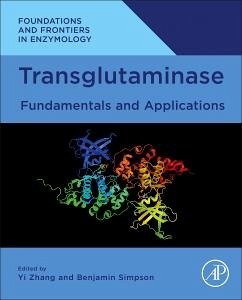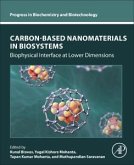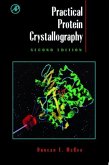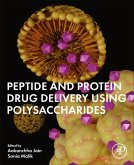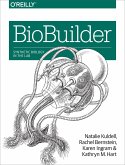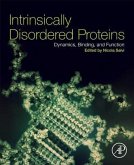Transglutaminase
Fundamentals and Applications
Herausgeber: Zhang, Yi; Simpson, Benjamin K
Transglutaminase
Fundamentals and Applications
Herausgeber: Zhang, Yi; Simpson, Benjamin K
- Broschiertes Buch
- Merkliste
- Auf die Merkliste
- Bewerten Bewerten
- Teilen
- Produkt teilen
- Produkterinnerung
- Produkterinnerung
Transglutaminase: Fundamentals and Applications, a new volume in the Foundations and Frontiers in Enzymology series, stands as a comprehensive resource on this increasingly important class of enzymes. Following an introduction to the field, international experts discuss basic biology and structure - function relationships of transglutaminases, ongoing fundamental research, and new application areas, including food processing, material synthesis, biomedicine, disease treatment, and biotechnology. Approaches for sourcing transglutaminases from animals, plants, and microorganisms are considered,…mehr
Andere Kunden interessierten sich auch für
![Carbon-Based Nanomaterials in Biosystems Carbon-Based Nanomaterials in Biosystems]() Carbon-Based Nanomaterials in Biosystems167,99 €
Carbon-Based Nanomaterials in Biosystems167,99 €![Practical Protein Crystallography Practical Protein Crystallography]() Duncan E. McReePractical Protein Crystallography131,99 €
Duncan E. McReePractical Protein Crystallography131,99 €![Ureases Ureases]() Ureases167,99 €
Ureases167,99 €![Protein Engineering and Design Protein Engineering and Design]() Paul R. Carey (ed.)Protein Engineering and Design105,99 €
Paul R. Carey (ed.)Protein Engineering and Design105,99 €![Peptide and Protein Drug Delivery Using Polysaccharides Peptide and Protein Drug Delivery Using Polysaccharides]() Peptide and Protein Drug Delivery Using Polysaccharides167,99 €
Peptide and Protein Drug Delivery Using Polysaccharides167,99 €![Biobuilder Biobuilder]() Natalie Kuldell PhdBiobuilder49,99 €
Natalie Kuldell PhdBiobuilder49,99 €![Intrinsically Disordered Proteins Intrinsically Disordered Proteins]() Intrinsically Disordered Proteins143,99 €
Intrinsically Disordered Proteins143,99 €-
-
-
Transglutaminase: Fundamentals and Applications, a new volume in the Foundations and Frontiers in Enzymology series, stands as a comprehensive resource on this increasingly important class of enzymes. Following an introduction to the field, international experts discuss basic biology and structure - function relationships of transglutaminases, ongoing fundamental research, and new application areas, including food processing, material synthesis, biomedicine, disease treatment, and biotechnology. Approaches for sourcing transglutaminases from animals, plants, and microorganisms are considered, followed by chapters on applied uses in biomedicine, skin, bone biology, medicine, drug development, tissue engineering, seafood bioprocessing, dairy bioprocessing, synthesis of materials and polymers, and as an immobilization agent. Research protocols are also provided, including research rationale, design, substrates, assays, and microassay steps for studying transglutaminases.
Hinweis: Dieser Artikel kann nur an eine deutsche Lieferadresse ausgeliefert werden.
Hinweis: Dieser Artikel kann nur an eine deutsche Lieferadresse ausgeliefert werden.
Produktdetails
- Produktdetails
- Foundations and Frontiers in Enzymology
- Verlag: Elsevier Science Publishing Co Inc
- Seitenzahl: 382
- Erscheinungstermin: 29. Februar 2024
- Englisch
- Abmessung: 234mm x 191mm x 20mm
- Gewicht: 804g
- ISBN-13: 9780443191688
- ISBN-10: 0443191689
- Artikelnr.: 68169655
- Herstellerkennzeichnung
- Libri GmbH
- Europaallee 1
- 36244 Bad Hersfeld
- gpsr@libri.de
- Foundations and Frontiers in Enzymology
- Verlag: Elsevier Science Publishing Co Inc
- Seitenzahl: 382
- Erscheinungstermin: 29. Februar 2024
- Englisch
- Abmessung: 234mm x 191mm x 20mm
- Gewicht: 804g
- ISBN-13: 9780443191688
- ISBN-10: 0443191689
- Artikelnr.: 68169655
- Herstellerkennzeichnung
- Libri GmbH
- Europaallee 1
- 36244 Bad Hersfeld
- gpsr@libri.de
An introduction to transglutaminases
Yi Zhang, Srividya Parthasarathy, and Benjamin K. Simpson
Chapter 1 Transglutaminases from microorganisms
Limin Wang and Yi Wang
1. Introduction
2. Microbial sources of TGase
3. Biotechnological production of MTGase
4. Concluding remarks and outlook
References
Chapter 2 Transglutaminases from plant sources
Stefano Del Duca and Giampiero Cai
1. Introduction
2. Phylogenetic relationship and bioinformatic analyses
3. Distribution and physiological roles of TGases in plants
4. Conclusions
References
Chapter 3 Transglutaminases from animals
Jirawat Yongsawatdigul, Ali Hamzeh and Bung-orn Hemung
1. Introduction
2. Function and distribution
3. Conclusions
References
Chapter 4 Newly engineered transglutaminases
Han Liu, Ishita Ghosh, Corinne Nardin and Yi Zhang
1. Introduction
2. Methodology for engineering transglutaminases
3. Newly engineered microbial transglutaminases
4. Newly engineered animal transglutaminases
5. Regulations
References
Chapter 5 Transglutaminase 2 in neurological conditions
Thomas Delgado and Gail V.W. Johnson
1. Discovery of TG2 and its association with proteinopathies
2. TG2’s complex role in neuron survival
3. TG2 in CNS injury and neuroinflammation
4. Epigenetic regulation by TG2
5. Conclusions
References
Chapter 6 Transglutaminases in cardiovascular health and disease
Lakshmi Santhanam
Abbreviations
1. Introduction
2. Transglutaminases in the cardiovascular system
3. Transglutaminases in vascular diseases
4. Transglutaminases in cardiac disease
5. Transglutaminases in thromboembolism
6. Conclusions and future perspectives
References
Chapter 7 Microbial transglutaminase in drug development
Riko Nishioka, Ryo Sato, Kazuki Uchida, Rie Wakabayashi and Noriho Kamiya
1. Introduction
2. Protein modification using small molecule substrates
3. Preparation of proteineprotein conjugates
4. Protein modification using synthetic polymeric substrates
5. Introduction of hydrophobic molecules into proteins
6. Conclusion
Acknowledgments
References
Chapter 8 Transglutaminases in meat and seafood bioprocessing
P¿nar Yerlikaya and Nalan Gokoglu
1. Transglutaminases in meat bioprocessing
2. Transglutaminases in seafood bioprocessing
3. Conclusion
References
Chapter 9 Transglutaminase in dairy processing
Ehab Romeih, Marek Kieliszek and Essam Hebishy
1. Introduction
2. MTGase applications in dairy processing
3. Conclusions and future remarks
References
Chapter 10 Transglutaminase in noodles, pastas, and baked products
Seyed Mohammad Taghi Gharibzahedi and Zeynep Altintas
1. Introduction
2. Noodle and TGase
3. Pasta and TGase
4. Bread and TGase
5. Other bakery products and TGase
6. Health and nutritional properties
7. Conclusions
Acknowledgments
References
Chapter 11 Transglutaminase in textile, wool, silk, and leather processing
Ning Zhang, Penghui Yang, Man Zhou, Qiang Wang, Song Liu and Jian Chen
1. Transglutaminase in wool processing
2. Transglutaminase in silk processing
3. Transglutaminase in leather processing
4. Conclusion
References
Chapter 12 Immobilization of transglutaminases and transglutaminase as
immobilization agent
Katja Vasic, Zeljko Knez and Maja Leitgeb
1. Introduction
2. Enzymatic properties of TGase
3. Production and substrate preference of TGase
4. TGase immobilization
5. TGase as immobilizing agent in food and
biotechnology industries
6. Conclusions
Acknowledgments
References
Chapter 13 Industrial production of transglutaminase
Keiichi Yokoyama
1. Background to food innovation with transglutaminase
2. Feasibility study on protein modification by TGase
3. Search for a TGase for industrial applications
4. Developments for MTGase commercialization
5. MTGase in nature
6. Recombinant production of MTGase
7. MTGase variants with improved properties
8. Food safety and regulation
9. Concluding remarks
References
Further reading
Index
Yi Zhang, Srividya Parthasarathy, and Benjamin K. Simpson
Chapter 1 Transglutaminases from microorganisms
Limin Wang and Yi Wang
1. Introduction
2. Microbial sources of TGase
3. Biotechnological production of MTGase
4. Concluding remarks and outlook
References
Chapter 2 Transglutaminases from plant sources
Stefano Del Duca and Giampiero Cai
1. Introduction
2. Phylogenetic relationship and bioinformatic analyses
3. Distribution and physiological roles of TGases in plants
4. Conclusions
References
Chapter 3 Transglutaminases from animals
Jirawat Yongsawatdigul, Ali Hamzeh and Bung-orn Hemung
1. Introduction
2. Function and distribution
3. Conclusions
References
Chapter 4 Newly engineered transglutaminases
Han Liu, Ishita Ghosh, Corinne Nardin and Yi Zhang
1. Introduction
2. Methodology for engineering transglutaminases
3. Newly engineered microbial transglutaminases
4. Newly engineered animal transglutaminases
5. Regulations
References
Chapter 5 Transglutaminase 2 in neurological conditions
Thomas Delgado and Gail V.W. Johnson
1. Discovery of TG2 and its association with proteinopathies
2. TG2’s complex role in neuron survival
3. TG2 in CNS injury and neuroinflammation
4. Epigenetic regulation by TG2
5. Conclusions
References
Chapter 6 Transglutaminases in cardiovascular health and disease
Lakshmi Santhanam
Abbreviations
1. Introduction
2. Transglutaminases in the cardiovascular system
3. Transglutaminases in vascular diseases
4. Transglutaminases in cardiac disease
5. Transglutaminases in thromboembolism
6. Conclusions and future perspectives
References
Chapter 7 Microbial transglutaminase in drug development
Riko Nishioka, Ryo Sato, Kazuki Uchida, Rie Wakabayashi and Noriho Kamiya
1. Introduction
2. Protein modification using small molecule substrates
3. Preparation of proteineprotein conjugates
4. Protein modification using synthetic polymeric substrates
5. Introduction of hydrophobic molecules into proteins
6. Conclusion
Acknowledgments
References
Chapter 8 Transglutaminases in meat and seafood bioprocessing
P¿nar Yerlikaya and Nalan Gokoglu
1. Transglutaminases in meat bioprocessing
2. Transglutaminases in seafood bioprocessing
3. Conclusion
References
Chapter 9 Transglutaminase in dairy processing
Ehab Romeih, Marek Kieliszek and Essam Hebishy
1. Introduction
2. MTGase applications in dairy processing
3. Conclusions and future remarks
References
Chapter 10 Transglutaminase in noodles, pastas, and baked products
Seyed Mohammad Taghi Gharibzahedi and Zeynep Altintas
1. Introduction
2. Noodle and TGase
3. Pasta and TGase
4. Bread and TGase
5. Other bakery products and TGase
6. Health and nutritional properties
7. Conclusions
Acknowledgments
References
Chapter 11 Transglutaminase in textile, wool, silk, and leather processing
Ning Zhang, Penghui Yang, Man Zhou, Qiang Wang, Song Liu and Jian Chen
1. Transglutaminase in wool processing
2. Transglutaminase in silk processing
3. Transglutaminase in leather processing
4. Conclusion
References
Chapter 12 Immobilization of transglutaminases and transglutaminase as
immobilization agent
Katja Vasic, Zeljko Knez and Maja Leitgeb
1. Introduction
2. Enzymatic properties of TGase
3. Production and substrate preference of TGase
4. TGase immobilization
5. TGase as immobilizing agent in food and
biotechnology industries
6. Conclusions
Acknowledgments
References
Chapter 13 Industrial production of transglutaminase
Keiichi Yokoyama
1. Background to food innovation with transglutaminase
2. Feasibility study on protein modification by TGase
3. Search for a TGase for industrial applications
4. Developments for MTGase commercialization
5. MTGase in nature
6. Recombinant production of MTGase
7. MTGase variants with improved properties
8. Food safety and regulation
9. Concluding remarks
References
Further reading
Index
An introduction to transglutaminases
Yi Zhang, Srividya Parthasarathy, and Benjamin K. Simpson
Chapter 1 Transglutaminases from microorganisms
Limin Wang and Yi Wang
1. Introduction
2. Microbial sources of TGase
3. Biotechnological production of MTGase
4. Concluding remarks and outlook
References
Chapter 2 Transglutaminases from plant sources
Stefano Del Duca and Giampiero Cai
1. Introduction
2. Phylogenetic relationship and bioinformatic analyses
3. Distribution and physiological roles of TGases in plants
4. Conclusions
References
Chapter 3 Transglutaminases from animals
Jirawat Yongsawatdigul, Ali Hamzeh and Bung-orn Hemung
1. Introduction
2. Function and distribution
3. Conclusions
References
Chapter 4 Newly engineered transglutaminases
Han Liu, Ishita Ghosh, Corinne Nardin and Yi Zhang
1. Introduction
2. Methodology for engineering transglutaminases
3. Newly engineered microbial transglutaminases
4. Newly engineered animal transglutaminases
5. Regulations
References
Chapter 5 Transglutaminase 2 in neurological conditions
Thomas Delgado and Gail V.W. Johnson
1. Discovery of TG2 and its association with proteinopathies
2. TG2’s complex role in neuron survival
3. TG2 in CNS injury and neuroinflammation
4. Epigenetic regulation by TG2
5. Conclusions
References
Chapter 6 Transglutaminases in cardiovascular health and disease
Lakshmi Santhanam
Abbreviations
1. Introduction
2. Transglutaminases in the cardiovascular system
3. Transglutaminases in vascular diseases
4. Transglutaminases in cardiac disease
5. Transglutaminases in thromboembolism
6. Conclusions and future perspectives
References
Chapter 7 Microbial transglutaminase in drug development
Riko Nishioka, Ryo Sato, Kazuki Uchida, Rie Wakabayashi and Noriho Kamiya
1. Introduction
2. Protein modification using small molecule substrates
3. Preparation of proteineprotein conjugates
4. Protein modification using synthetic polymeric substrates
5. Introduction of hydrophobic molecules into proteins
6. Conclusion
Acknowledgments
References
Chapter 8 Transglutaminases in meat and seafood bioprocessing
P¿nar Yerlikaya and Nalan Gokoglu
1. Transglutaminases in meat bioprocessing
2. Transglutaminases in seafood bioprocessing
3. Conclusion
References
Chapter 9 Transglutaminase in dairy processing
Ehab Romeih, Marek Kieliszek and Essam Hebishy
1. Introduction
2. MTGase applications in dairy processing
3. Conclusions and future remarks
References
Chapter 10 Transglutaminase in noodles, pastas, and baked products
Seyed Mohammad Taghi Gharibzahedi and Zeynep Altintas
1. Introduction
2. Noodle and TGase
3. Pasta and TGase
4. Bread and TGase
5. Other bakery products and TGase
6. Health and nutritional properties
7. Conclusions
Acknowledgments
References
Chapter 11 Transglutaminase in textile, wool, silk, and leather processing
Ning Zhang, Penghui Yang, Man Zhou, Qiang Wang, Song Liu and Jian Chen
1. Transglutaminase in wool processing
2. Transglutaminase in silk processing
3. Transglutaminase in leather processing
4. Conclusion
References
Chapter 12 Immobilization of transglutaminases and transglutaminase as
immobilization agent
Katja Vasic, Zeljko Knez and Maja Leitgeb
1. Introduction
2. Enzymatic properties of TGase
3. Production and substrate preference of TGase
4. TGase immobilization
5. TGase as immobilizing agent in food and
biotechnology industries
6. Conclusions
Acknowledgments
References
Chapter 13 Industrial production of transglutaminase
Keiichi Yokoyama
1. Background to food innovation with transglutaminase
2. Feasibility study on protein modification by TGase
3. Search for a TGase for industrial applications
4. Developments for MTGase commercialization
5. MTGase in nature
6. Recombinant production of MTGase
7. MTGase variants with improved properties
8. Food safety and regulation
9. Concluding remarks
References
Further reading
Index
Yi Zhang, Srividya Parthasarathy, and Benjamin K. Simpson
Chapter 1 Transglutaminases from microorganisms
Limin Wang and Yi Wang
1. Introduction
2. Microbial sources of TGase
3. Biotechnological production of MTGase
4. Concluding remarks and outlook
References
Chapter 2 Transglutaminases from plant sources
Stefano Del Duca and Giampiero Cai
1. Introduction
2. Phylogenetic relationship and bioinformatic analyses
3. Distribution and physiological roles of TGases in plants
4. Conclusions
References
Chapter 3 Transglutaminases from animals
Jirawat Yongsawatdigul, Ali Hamzeh and Bung-orn Hemung
1. Introduction
2. Function and distribution
3. Conclusions
References
Chapter 4 Newly engineered transglutaminases
Han Liu, Ishita Ghosh, Corinne Nardin and Yi Zhang
1. Introduction
2. Methodology for engineering transglutaminases
3. Newly engineered microbial transglutaminases
4. Newly engineered animal transglutaminases
5. Regulations
References
Chapter 5 Transglutaminase 2 in neurological conditions
Thomas Delgado and Gail V.W. Johnson
1. Discovery of TG2 and its association with proteinopathies
2. TG2’s complex role in neuron survival
3. TG2 in CNS injury and neuroinflammation
4. Epigenetic regulation by TG2
5. Conclusions
References
Chapter 6 Transglutaminases in cardiovascular health and disease
Lakshmi Santhanam
Abbreviations
1. Introduction
2. Transglutaminases in the cardiovascular system
3. Transglutaminases in vascular diseases
4. Transglutaminases in cardiac disease
5. Transglutaminases in thromboembolism
6. Conclusions and future perspectives
References
Chapter 7 Microbial transglutaminase in drug development
Riko Nishioka, Ryo Sato, Kazuki Uchida, Rie Wakabayashi and Noriho Kamiya
1. Introduction
2. Protein modification using small molecule substrates
3. Preparation of proteineprotein conjugates
4. Protein modification using synthetic polymeric substrates
5. Introduction of hydrophobic molecules into proteins
6. Conclusion
Acknowledgments
References
Chapter 8 Transglutaminases in meat and seafood bioprocessing
P¿nar Yerlikaya and Nalan Gokoglu
1. Transglutaminases in meat bioprocessing
2. Transglutaminases in seafood bioprocessing
3. Conclusion
References
Chapter 9 Transglutaminase in dairy processing
Ehab Romeih, Marek Kieliszek and Essam Hebishy
1. Introduction
2. MTGase applications in dairy processing
3. Conclusions and future remarks
References
Chapter 10 Transglutaminase in noodles, pastas, and baked products
Seyed Mohammad Taghi Gharibzahedi and Zeynep Altintas
1. Introduction
2. Noodle and TGase
3. Pasta and TGase
4. Bread and TGase
5. Other bakery products and TGase
6. Health and nutritional properties
7. Conclusions
Acknowledgments
References
Chapter 11 Transglutaminase in textile, wool, silk, and leather processing
Ning Zhang, Penghui Yang, Man Zhou, Qiang Wang, Song Liu and Jian Chen
1. Transglutaminase in wool processing
2. Transglutaminase in silk processing
3. Transglutaminase in leather processing
4. Conclusion
References
Chapter 12 Immobilization of transglutaminases and transglutaminase as
immobilization agent
Katja Vasic, Zeljko Knez and Maja Leitgeb
1. Introduction
2. Enzymatic properties of TGase
3. Production and substrate preference of TGase
4. TGase immobilization
5. TGase as immobilizing agent in food and
biotechnology industries
6. Conclusions
Acknowledgments
References
Chapter 13 Industrial production of transglutaminase
Keiichi Yokoyama
1. Background to food innovation with transglutaminase
2. Feasibility study on protein modification by TGase
3. Search for a TGase for industrial applications
4. Developments for MTGase commercialization
5. MTGase in nature
6. Recombinant production of MTGase
7. MTGase variants with improved properties
8. Food safety and regulation
9. Concluding remarks
References
Further reading
Index

